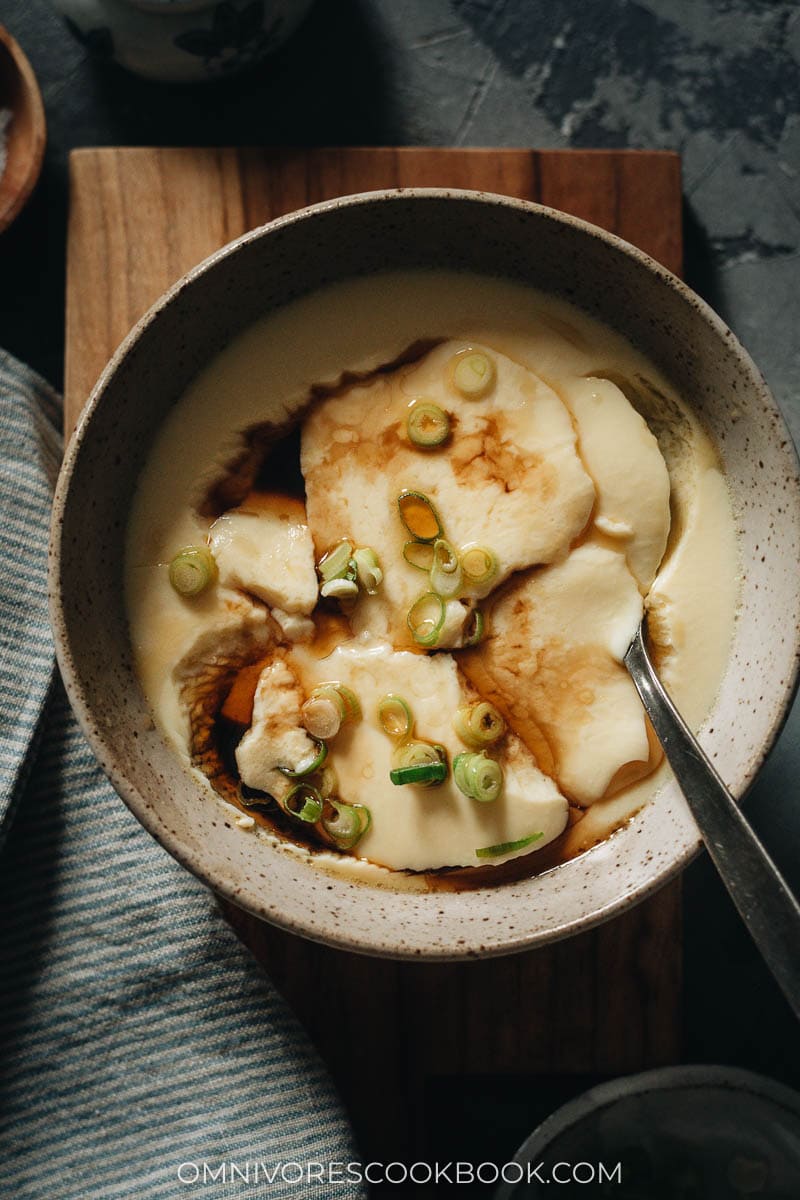
Chinese steamed eggs bring back happy memories of my childhood. My mom would always make this homestyle dish for me and whenever I make it, I’m instantly a kid again in those happy and wonderful days when life was much more carefree. Whenever I want something comforting for breakfast, or something warm and soothing when I’m feeling under the weather, Chinese steamed eggs are usually the answer.
Also, I must confess that I love eggs just about any way you can make them. There are so many ways to make them too. But if you love eggs and haven’t had Chinese steamed eggs, you’ve been missing out. Now you can make them in less than 20 minutes with just five ingredients that you probably already have in your kitchen right now.
You might be wondering what Chinese steamed eggs taste like. With this cooking method, you get to taste the freshness and flavor of the eggs. They’re accentuated with just a little soy sauce, sesame oil, and green onion for added fragrance. The texture is very smooth and silky, a perfect complement to the elegant flavors.
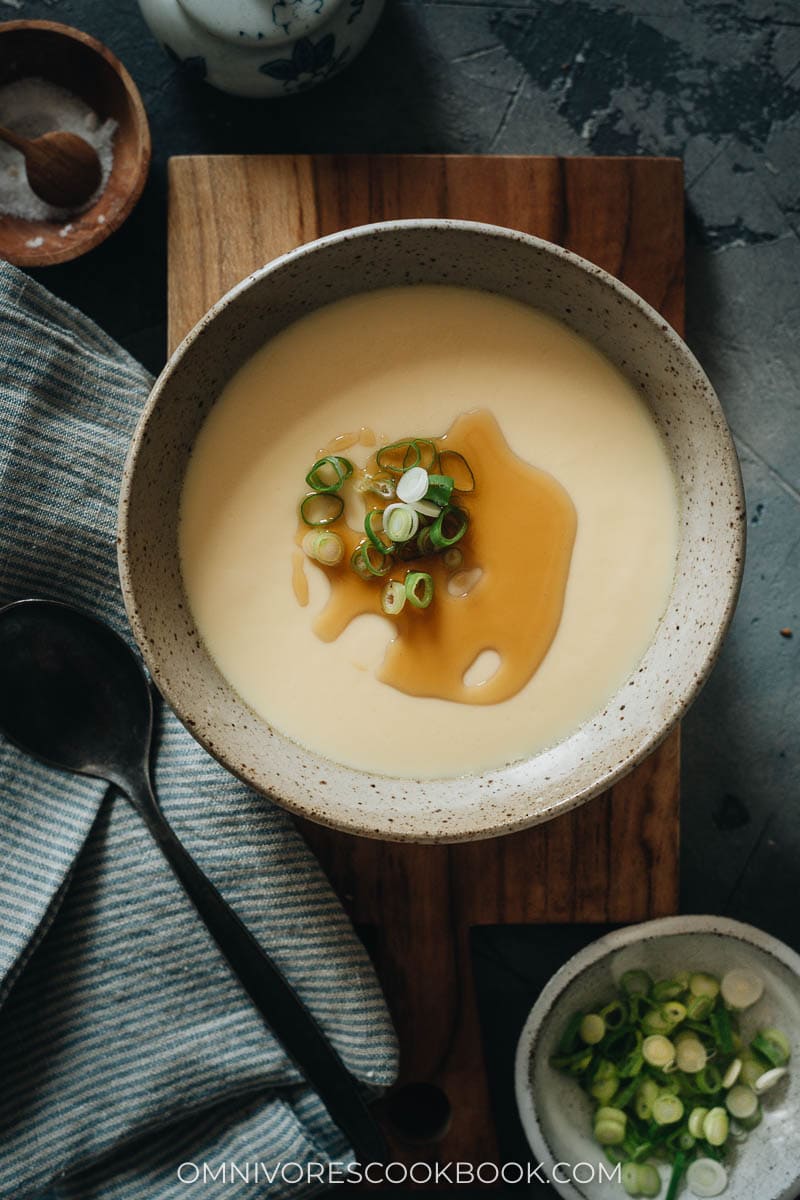
Chinese steamed eggs
Other Asian countries also make steamed egg dishes, but the Chinese version is my favorite because it’s simple yet hearty. It allows the taste of the eggs to shine, and if you love eggs as much as I do, you’re going to appreciate it.
I prefer my Chinese steamed eggs to be extra soft so I use more water, just like my mom always does. But if you’d prefer a firmer texture, you can certainly create it by reducing the water. It’s a bit of a balance as you’ll see in my steps below. Too much water will prevent the eggs from setting properly.
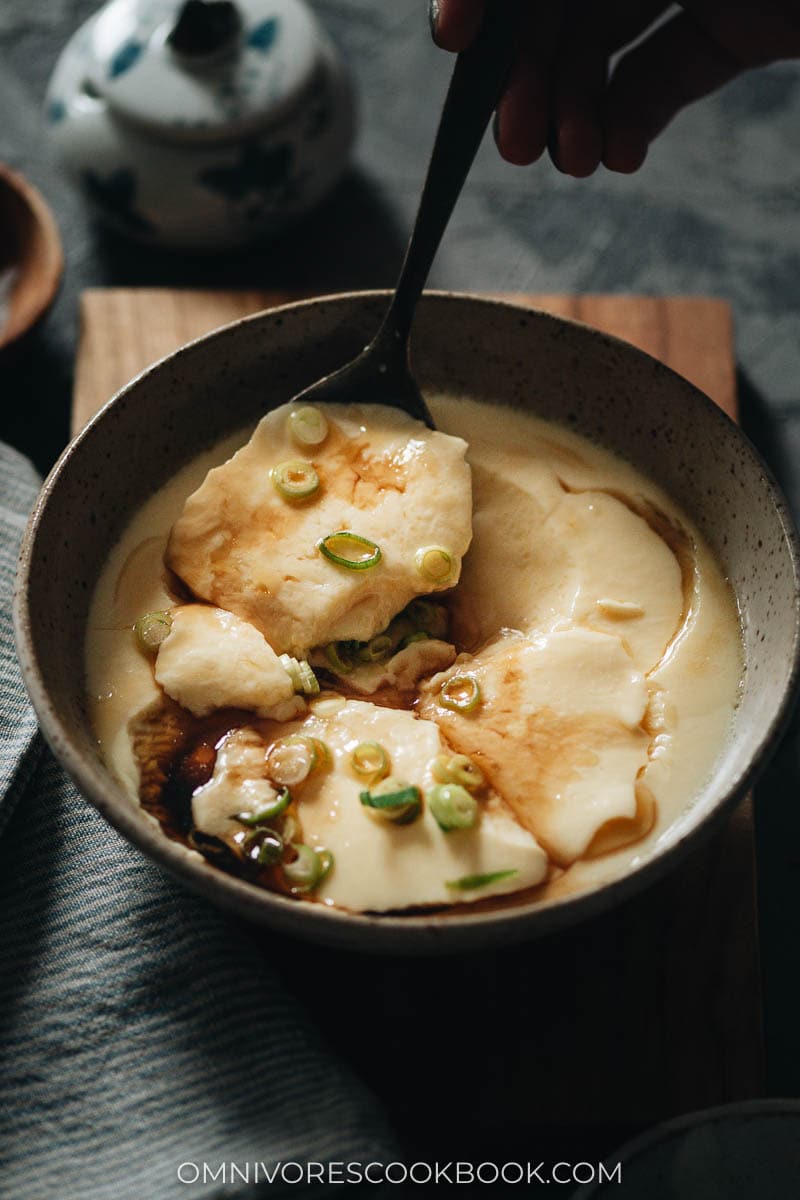
Cooking process
For Chinese steamed eggs, you beat the eggs with water and steam them to create a soft egg curd and then top it with the accents.
- Beat the eggs in a measuring cup
- Add warm water and mix again
- Strain the eggs
- Cover the bowl with plastic wrap and poke holes on top
Then steam it until the eggs are just set. Add the garnish you prefer, and enjoy!
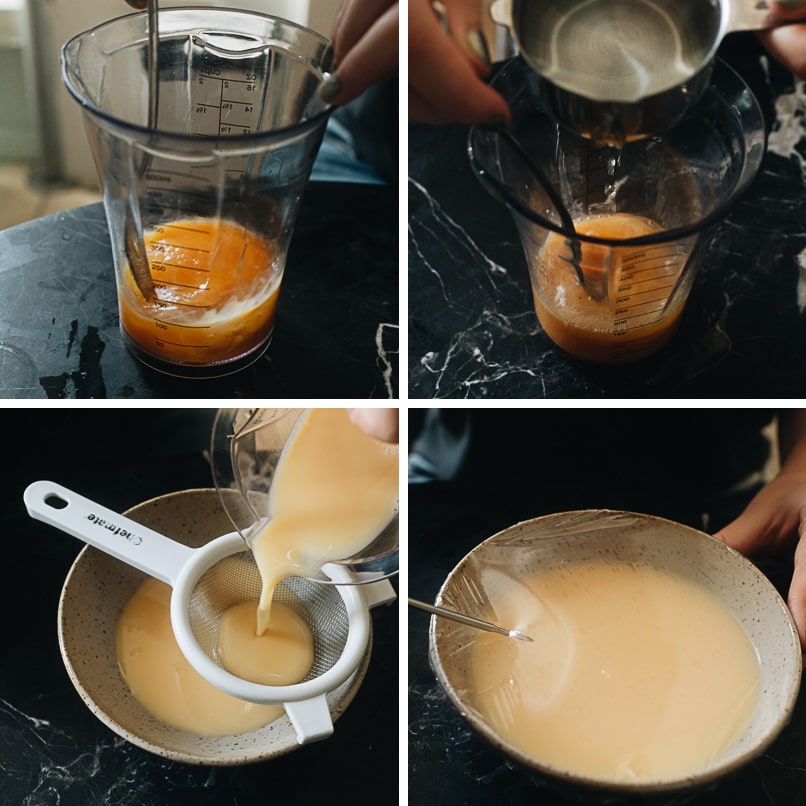
Cooking notes
Super smooth texture
Just a trick my mom taught me. You’ll want to add warm water (just above body temperature) to your beaten eggs to temper them. It will ensure the texture becomes smooth and silky once cooked. Ever since she taught me that, I’ve been using it to make my Chinese steamed eggs come out just the way I remember her making them for me.
If you’re not sure about the water temperature, simply boil some water and use 1 part boiling water and 1 part room temperature water.
Water volume
The water volume will determine the texture of the steamed eggs. My favorite steamed eggs use as much water as possible so the eggs will just set and form a very soft curd. The golden ratio is 1 part egg to slightly less than 2 parts water. The most accurate way is to use a measuring cup.
If you do not have a measuring cup, the safest way is to use 2 large eggs (about 1/2 cup) with 3/4 cup water. So the eggs will set and the texture will remain soft.
Cooking time
The cooking time can vary depending on the container you use. I highly recommend using a heat-proof glass container or bowl for the dish. It will heat up faster and cook the eggs more evenly.
For aesthetics’ sake, I used a ceramic bowl in my recipe. It requires a slightly longer cooking time. It worked out nicely but it did require some trial and error for me to figure out the perfect cooking time.
I’ve provided detailed instructions in the recipe below. If you like this dish and plan to cook it a lot, you should use one bowl of your choice and tweak the cooking time until it reaches the desired consistency.
But rest assured, even if you slightly overcook the eggs, they will still turn out tasty. The steamed eggs will be silky and soft, with a texture that’s more like pudding than a soft curd.
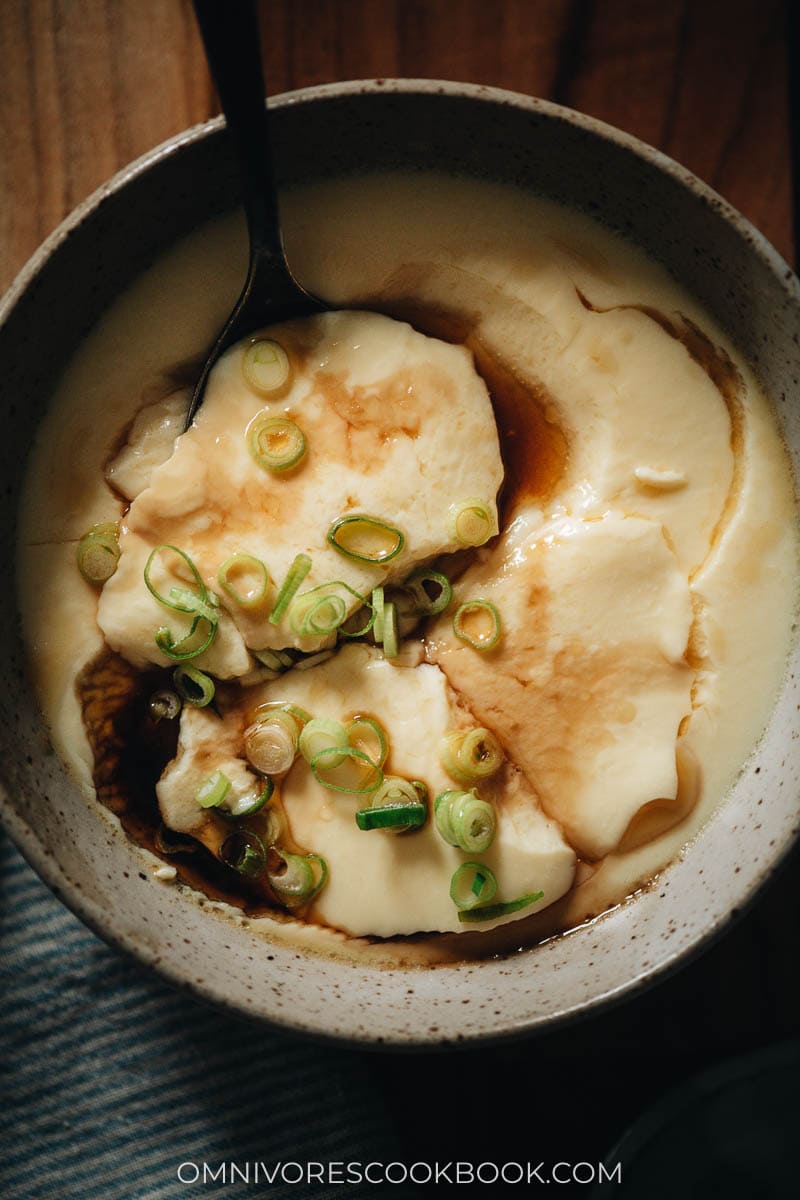
How to serve the steamed eggs
As I mentioned, steamed eggs are a classic breakfast dish in China, though you can eat them as a side for any meal or any time of the day as a snack. I typically like to make them when I need something comforting or feel under the weather. It’s also a great dish for small kids, because the texture of the eggs is very tender and their flavor mild.
I hope it will become an ultra comforting dish for you as well!
Want to learn more about Chinese Cooking? Sign up my newsletter to receive the 5-Day Chinese Cooking Crash Course and recipe update!
Chinese Cooking Made Easy
Are you new to this website? This free email series is a great place to start. I’ll walk you through a few of my most popular recipes and show you how and why they work. You’ll quickly start to cook better Chinese food in your own kitchen.
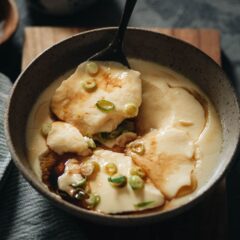
Chinese Steamed Eggs (鸡蛋羹)
Ingredients
- 2 large eggs
- 1/4 teaspoon salt
- 3/4 cup warm water , or according to the size of your eggs (*Footnote 1)
Garnish
- green onions , Sliced
- Light soy sauce (or tamari for gluten-free) (Optional)
- Sesame oil
Instructions
- Prepare the steamer and bring the water to a boil.
- Break the eggs into a liquid measuring cup and add the salt. Beat the eggs with a fork until they are smooth, but not airy. Check the volume measurement of the beaten eggs, it should be about 1/2 cup.
- Add the water, just under two times the volume of the egg, just slightly above 3/4 cup (about 1 tablespoon more) in most cases (*Footnote 2). Whisk until the mixture is consistent.
- Prepare a heat-proof bowl or container that can fit in your steamer. It can be a big wide bowl that’s about 24 oz (700 ml) or two 12-oz (350 ml) ramekins. (*Footnote 3)
- Using a fine mesh strainer, strain the eggs into the bowl you prepared. If there are any bubbles on the surface, use a spoon to gently scoop them off. Cover the bowl with plastic wrap and poke a few small holes in it.
- Reduce the heat of the steamer to medium-low. Carefully transfer the bowl with the egg into the steamer.
- Steam for 7 to 12 minutes, until the eggs are just set. After 7 minutes, lightly shimmy the steamer rack or the bowl to judge how set your eggs are. The eggs should jiggle slightly without any obvious liquid on or under the center of the surface. Let it cook longer, if needed, until the eggs are set. (*Footnote 5)
- After the steaming is done, turn the heat off and transfer the bowl onto a coaster or trivet. Let the eggs rest for 5 minutes. Carefully peel off the plastic wrap. Drizzle with sesame oil and light soy sauce and garnish with green onion.
- Serve hot as breakfast or as a snack.
Notes
- The water temperature should be around 100-110°F (38°C), just a bit above body temperature. The warm water will temper the eggs so it yields a smooth result when steamed.
- The water ratio should be just under 2x the volume of the eggs to create the softest result. If you use too much water, the eggs won’t set. If you use too little water, the texture will become a bit harder.
- The shape of the bowl affects the cooking time. It’s the best to use a wide heatproof glass bowl. You can use a ceramic bowl as well. The thicker and taller the bowl you use, the longer the cooking time.
- The amount of steaming time can vary a lot depending on the size, shape, and material of the container used. Thin metal or plastic will cook faster than ceramic. Shallow, wide dishes will also lead to a faster cook time. If using one container it will likely take longer than if you cook the same number of eggs in two containers.
- I used a thick-ish ceramic bowl that is about 6.5” (16 cm) wide and 2.3” (5.8 cm) tall. It took me 9 minutes of cooking time and 5 minutes of resting time to get the perfect texture.
Nutrition

Did you make this recipe?
I’d love to hear how it turned out for you! Please take a moment to leave a 5-star rating ⭐️ and share your thoughts in the comments further down the page. It really helps others discover the recipe too.
If you give this recipe a try, let us know! Leave a comment, rate it (once you’ve tried it), and take a picture and tag it @omnivorescookbook on Instagram! I’d love to see what you come up with.
More homestyle comfort food
- Bok Choy Soup
- 10-Minute Spam Ramen
- Classic Tomato and Egg Stir-Fry (西红柿炒鸡蛋)
- Chinese Napa Cabbage with Glass Noodles
- Chinese Chive Pockets
Lilja Walter is a part of the Omnivore’s Cookbook team and worked closely with Maggie to develop and test this recipe.

Feifei
Hi Maggie, this is the first time I’ve used broth while making this dish. It tasted great and my husband also loved it! Thank you for sharing this simple but tasty Chinese treat!
Anne
What should I do if steam egg turned out too water?
How to secure? Put more egg or steam longer?
Maggie Zhu
You can add one more egg or reduce the water slightly.
KB
This was delicious. I used a more traditional rounded bowl, rather than a flattened one. It took about 9 mins, then I left for 3 mins without stove on, and 2 mins out of pot to cook. I served with nutritional yeast, coconut aminos, tamari, sesame oil, sesame seeds, chili flakes, and sliced scallions. A+! It was worth the wait and minimal prep. Loved this recipe and will make again. Thank you
Quinn
This is one of the very few Chinese recipes that I learned to master before discovering this blog. I do mine a bit different. I blend four eggs with one cup of whole milk instead of water (my “golden ratio'” for this dish). I strain this mixture into two small bowls that are in an inch of cold water in a pan. I put the lid on the pan and place it on low heat until it starts to boil, which I can hear because the bowls start to rattle in the pan. I then shut off the heat and leave the lid on for about 20 minutes.
The trick with this dish is to bring it up to temperature slowly so that the eggs achieve a custard-like consistency. If too fast, then the texture is more like scrambled eggs.
It might take a few tries to get it just right, but the end result is worth it!
Paulinn
Yummy especially as late night snack. Easy to make recipe. Add in dried scallops into the eggs for better taste!
Rachel
I’m in love with these eggs! They turned out so soft and smooth and perfectly custardy! I love the mesh strainer trick, and I used the instant pot on the steam setting with the full 12 minutes and they came out just right. Thank you!
Hannah
Thanks for the Instapot tip! I have a traditional bamboo steamer, but I don’t like to break it out for everyday use.
Sally Emerich
I had some fresh duck eggs, made this and well, yum! Wonderful addition to my egg repertoire.
Amy
This worked great! I even made a few mistakes like missing the step of the plastic for the first 4 min and it still worked. I added the plastic and cooked for a little bit longer.
Kelsey
Just made this and it was the smoothest silkiest most yummy eggs I ever ate. So glad I found this recipe, thank you!
Jean W
Love your blog, Maggie. I would like to try your recipe for steamed eggs but it calls for the use of plastic wrap. The FDA does not recommend the use of plastic wrap in the cooking of food unless the wrap is made specifically for cooking. Would covering the eggs in aluminum foil work just as well?
Maggie
Yes. Aluminum foil works too (don’t forget to poke some holes on it). If you don’t mind the surface to be less perfect, you don’t need to cover the bowl at all. My mom never does it, but sometimes the water drops to the eggs from the lid.
JG
Hi Maggie, I don’t have a steamer. Can these be made in the microwave?
Thanks!
Maggie
I’m afraid not. The microwave’s output is very strong and it will over cook the eggs and result in a weird texture… I’ve seen chefs done that but I wouldn’t cook eggs in a microwave.
Michael
All you need is a large pot or sauce pan with lid. Put the water egg in a shallow dish or bowl that can fit inside the pot. Find something that you can place underneath the dish or bowl and fill with enough water just to the top of the bottom stack. You can use two small ceramic plates, a small bowl or anything that can withstand the boiling water. They do sell those round wire racks, some taller and some shorter at most Asian markets.